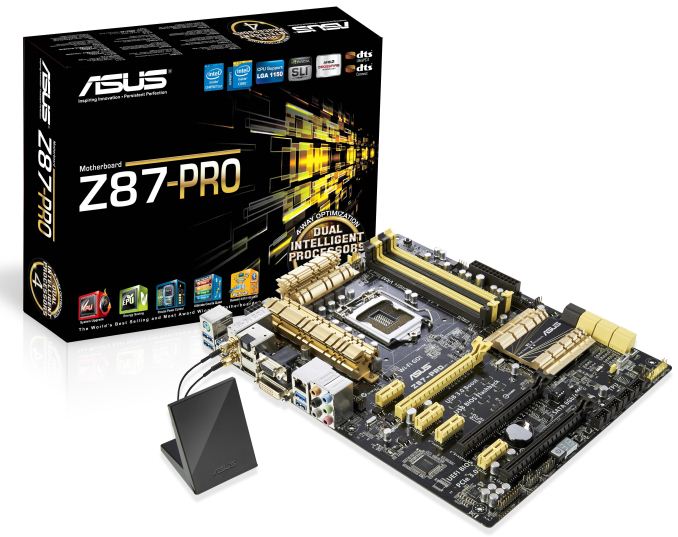Intel Z87 Motherboard Review with Haswell: Gigabyte, MSI, ASRock and ASUS
by Ian Cutress on June 27, 2013 8:00 AM EST- Posted in
- Motherboards
- Intel
- MSI
- Gigabyte
- ASRock
- Asus
- Haswell
- Z87
- Shark Bay
- Lynx Point
ASUS Z87-Pro Conclusion
The ASUS Z87-Pro sits between a rock and a hard place. ASUS is one of few motherboard companies that sit on the crest of innovation, coming up with new ideas that ultimately will filter through product ranges in each successive generation. Obviously the ones coming up with the ideas face the brunt of the cost, but unlike the medicine industry where markups are common if there is a sole solution to your problem, the motherboard market is cut-throat enough that the resellers, system integrators and end users dictate the pace of play with their wallet.
With all this being said it should be pointed out that the $200 price point is littered with competition, as we have already seen throughout this review. A motherboard manufacturer had to decide on layout, features, BOM costs and connectivity months ago – should they make a board designed to be at a higher price point and bring the cost down, or pull a motherboard up with a knockout blow on the credibility of the range. The ASUS comes into the market with a new style, new features, upgraded software and an incredibly nice to use BIOS. But at the same price point, other motherboards with more ports, more NICs, and 802.11ac exist. This is the hard point.
As far as testing the Z87 Pro, where have a large number of good points to discuss. The motherboard is efficient, boots fast, and has one of the better ALC1150 implementations despite not going the full way through to SupremeFX on the ROG side. Overclocking was also positive, and the ASMedia USB 3.0 ports reported similar speeds to the Intel points due to the lack of need for an ASMedia USB driver – the standard Intel one takes care of it.
The decision of ASUS to drop MultiCore Turbo from the main BIOS track is going to be a little strange, given that ASUS were the main protagonists in this field for the past two generations. MultiCore Turbo, when enabled, offers up to an additional 7% performance over a non-MCT enabled motherboard at stock settings and at full loading. The reasons given are simple: under stock conditions (i7-4770K in a case with the stock Intel cooler), a small (sub 5%) percentage of CPUs are forced to throttle due to heat generated. This is a combination of the Haswell architecture, the new stock Intel cooler, and features such as Adaptive Mode which struggle under artificial load. It kind of makes sense from a manufacturing point of view, but users who want MCT can follow the 3xxx BIOS track which has MCT enabled by default, or users can enable the option in the BIOS on the 1xxx track.
Another design choice made by ASUS is relating to the final PCIe slot. The board is wired up for PCIe 3.0 x8/x8 from the CPU and an additional PCIe 2.0 x4 from the chipset. ASUS have configured the chipset to output a total of eight PCIe 2.0 lanes, to power all the PCIe 2.0 x1 slots (of which there are four), various controllers and the final full length PCIe slot. However, in order to give everything wired up full bandwidth requires more than eight lanes, and thus various resources are shared. As a result, this final full length PCIe 2.0 runs at x1 by default, and requires a BIOS option to change it to x4, which in the process disables at least the ASMedia SATA 6 Gbps controller, reducing the total number of SATA 6 Gbps ports by two. This final PCIe slot can also be used in 3-way CrossFireX, but without careful consideration the performance difference between the final slot at x1 and x4 can be very large – in a couple of circumstances (Dirt3/Civ5) worse than just two GPUs on their own. For maximum GPU performance, the user would need to change the BIOS option to PCIe 2.0 x4. This is perhaps not painfully obvious unless the user has experienced lane bandwidth issues in the past; ideally I would like to see some software tool in the OS that could be enabled explaining the situation. Note this does not apply to GPUs specifically – PCIe 2.0 x4 RAID cards could also suffer in performance at x1 bandwidth.
Whenever a user considers purchasing this ASUS motherboard they should know that it is built to perform and has a great feature set, especially in terms of the BIOS and software but the additional hardware features such as BIOS Flashback and Fan XPert 2 are hard to ignore. The competition in the same price segment comes from companies that do not have that software backbone but are able to place more of everything and match the price of the ASUS. The ASRock Z87 Extreme6/AC is just one example of that competition that we have tested, and it is a task to decide between the strong build of the ASUS with DIP4/FanXPert2 against the dual Intel NIC/802.11ac/10 SATA 6 Gbps of the ASRock. Perhaps I am a little impressed by the way the latter has breached the price point, but the ASUS is a recommended motherboard for sure when considering any Z87 build. It only makes me wonder how other motherboards like the ASUS Z87 Sabertooth and ASUS Maximus VI Extreme perform – I hope we get them in to test.
For a great overall test, features and performance, I have no qualms in adding the ASUS Z87-Pro to our list of recommended motherboards and would like to give it our Silver award.
ASUS Z87-Pro
AnandTech Editor’s Choice Silver Award












58 Comments
View All Comments
HexiumVII - Sunday, June 30, 2013 - link
Hey Ian! Maybe run the Asrock Z87 in water and let us know how waterproof it is!Hrel - Monday, July 8, 2013 - link
You guys DO talk about how motherboard manufacturers have less and less to do now; with Intel moving more and more things onto the CPU die. Yet for some reason you still fail to ask WHY motherboards are getting MORE expensive. Not less. I got an AMAZING motherboard with SLI and massive overclocking ability that's rock solid back in 2007 for 125 dollars. Yet now that the northbridge isn't even ON the motherboard anymore I have to pay 175 for the SAME level of performance... WTF is that!adridu59 - Monday, July 8, 2013 - link
It looks like you are playing the marketing game, because ALC1150 (nominally ALC900) is just a tweaked ALC898 (same as ALC889 and ALC892).More info: http://www.overclock.net/t/1398739/is-realteks-alc...
Rafalus - Sunday, July 28, 2013 - link
Hi, Is it possible to stop TPU tuning eg when it reach 4.5GHz as I did not want to raise it higher?SilentRyder - Tuesday, October 22, 2013 - link
Honestly i believe this integrated Voltage Regulator will cause many problems. If we check the previous Ivy Bridge main boards, They do have a huge power regulator designed on the top side of processor socket. Now the whole idea of power supplied from the mainboard is gone off. May be this technology will benefit laptops or any other mobile devices. but this is certainly a bad idea for desktop users.We would certainly have HEAT problems, which i am truly afraid of. I do not think haswell will support enough for overclocking. i never over clock my self but i am sure INTEL will change this concept on its new generations.
Even laptops running in high temperature can be a issue.
How many of us are satisfied with the intel built in Graphics processor?
clyman - Tuesday, November 26, 2013 - link
So far, it meets my needs just fine. I am sure it would meet the needs of all my customers. I did put a fluid filled cooler on the processor, but that was only needed while running OCCT. I will add a video card should i ever need one.clyman - Tuesday, November 26, 2013 - link
I have the ASUS Z87-PRO mobo and was hoping someone had a few answers here for me, haven't seen anything related though. My problem is that no matter what I do, the multiplier will not go above 39 and I cannot find out why. Is that due to having 1600 MHZ memory?Another issue is that when I update AI Suite 3 from the original on the supplied CD, it will not recognize my WIFI Engine adapter, however it finds it with the original. ASUS techs have been useless on both of these points as they say have no information regarding overclocking and no one has a clue about the WIFI Engine. I have been given all kinds of advice, all fruitless. I can't get them to understand it simply will not recognize the device on the updated version. I think it is a bad update, they want to RMA it.
Any help on these issues would be appreciated.
LoCk3d - Friday, December 20, 2013 - link
A problem encountered someone USB Charger + function? I do not detect the device, I enabled ERP in bios but still does not work. Help me please !